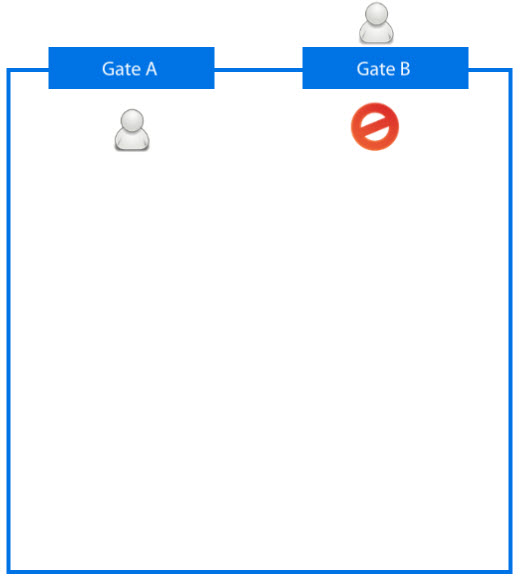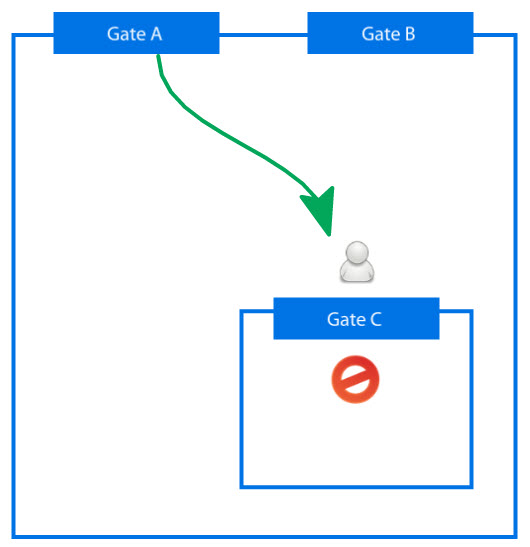•Access Control and Scanning Through Gates
•Zone Scenario - Ticket Handover Scenarios
•Zone Scenario - Internal Access
Gates are physically controlled access points used to control a ticket's access to the venue (in or out) and movement within the venue. Movement and access are determined by scanning tickets using Access Control. When configuring a venue, you do not need to configure any gates; however, you should consider configuring gates if you have multiple points of entry to the venue (or within the venue) and want to control access to a gate. If no gates are configured on the venue, scanned tickets will granted access to the venue based on the ticket number and the event that the ticket is being scanned against.
The following sections describe how to work with gates:
Access Control and Scanning Through Gates
To use the scanning features described below, you must use Access Control and properly configure scanners. If you are not using Access Control, you can still configure gates which can then be used to print on tickets, for example. For more information on configuring and using Access Control and the processes that happen when tickets are scanned, refer to Access Control.
Zones
Zones allow you to identify an area that customers pass into when they scan in through a gate. If your venue has internal areas with gates then you must use zones to identify those areas. As customers scan through a gate, the into zone will be recorded against the ticket record. All of the zones that the customer has scanned into will be captured (up to maximum of six). If customers scan out of a gate, the into zone configured on that gate will be removed from the list of zones that have been scanned. With correct configuration, once the customer leaves the venue the list of scanned zones will be empty. If the into zone of a gate does not match any of the zones that customers have scanned into then the ticket will not be allowed to scan out of the gate.
If a zone is not configured on a gate, when customers scan in through the gate the ticket will be considered as being in an empty zone. If the ticket is presented at a gate that also has no zone configured then the ticket will not be allowed to pass through that gate since the ticket is already in the empty zone.
Zone Scenario - Ticket Handover Scenarios
In this scenario, there are two external gates to the venue. Both of the gates are configured without a zone. When customers scan through Gate A, the ticket’s zone is marked as empty. If customers attempt to hand their ticket over Gate B to a friend who wants to try to get in with the same ticket, the system will not allow the ticket to be scanned into the empty zone again.

Zone Scenario - Internal Access
In this scenario, there are two external gates and one internal gate (a gate inside the venue) which gives access to the VIP lounge. All of the gates have been configured without zones. We want customers to be able to scan through Gate A to access the venue and then through Gate C to access the VIP lounge. Sadly, the customers in this example is going to be disappointed because there is no zone to scan into. The tickets were marked as being in the empty zone when customers scanned into Gate A. When the ticket is presented at Gate C the system will not allow the ticket to be scanned into the empty zone again.

For this scenario to work we need to tell the system to allow the ticket to be scanned into multiple areas of the venue. This is why we need to configure zones. We can configure Gate A and Gate B so that tickets will be scanned into the Venue zone. We can then configure Gate C so that the ticket will be scanned into the VIP zone. Now, when customers scan into Gate A their tickets will be marked as being in the Venue zone. When their tickets are scanned at Gate C the system will check whether the ticket has already been scanned into the VIP zone. If it has not, the tickets will be allowed through the gate.

Gate Access Rules
Gate access rules can be defined against a gate so that only specific seats, rows, sections and/or price types can access the gate (VIP seating, designated supporters gates). If no rules are defined, all tickets will grant customers access via all gates.
Event-specific gate access rules can be creted via the Admissions Management|Gates page. Any access rules set against an event will override those set against the venue.
Third-Party Tickets
If your organization will be scanning tickets from a third party, Access Control will only validate whether the ticket is for a valid event. This means that the third party ticket holder will be able to enter or exit any gate. For more information on setting up third party tickets, refer to Adding or Cancelling Third-Party Tickets.